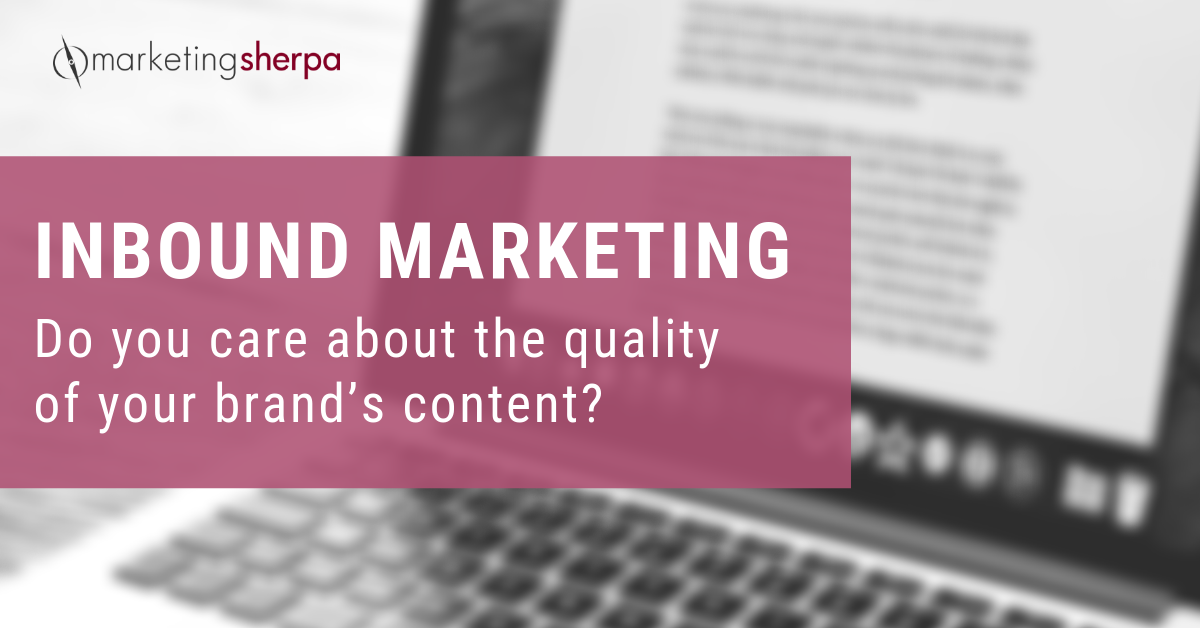Inbound Marketing: Do you care about the quality of your brand’s content?
If I had to break down the world of content marketing into two groups, it would be these:
- Those who care about the quality of their content
- And those who don’t
Ouch. Seeing those words in writing, my statement is a little harsh. So let me try to rephrase:
- Those who only see content as a means to an end
- And those who view content as an (often free) product that should have value in and of itself
To further refine this split, we could say there are two content marketing approaches we can simply label:
- Quantity
- Quality
Of course, every piece of content offers some level of value. You need a certain level of consistent production for even the most high-quality content. And there are shades of gray between the two extremes.
That said, I’ve noticed more and more of a focus on the “high quantity/means-to-an-end” approach as the content marketing industry has matured. Brands that seem like they don’t care about the quality of the content they’re producing, or at least not nearly as much as the volume. I thought this would make a fitting topic of exploration in today’s MarketingSherpa blog post.
This article was originally published in the MarketingSherpa inbound newsletter.
Content pollution
Content marketing has shown impressive growth as a marketing tactic. One reason for that is the proliferation of digital platforms and the growth of computing power allowing for less expensive production of content.
If you’ve ever listened to a talk by content guru Joe Pulizzi, you know that content marketing isn’t necessarily new. But when the means of production transitioned from a printing press and six-figure Avid system to a free blogging platform and smartphone, it was inevitable for content marketing to grow.
But there’s another reason it grew as well. It was effective. And it was effective because it was disruptive.
The traditional advertising and marketing model was built around selling to the prospective customer. The core of content marketing is helping the customer. When done well, customers sell themselves.
The low barriers to entry and “free” cost compared to paid media led to explosive growth in the amount of content. This has created plenty of helpful content. But content creation has also been used as part of a major quantity push by companies viewing it as a means to an end to attract traffic.
Process is easy; art is painful
This means-to-an-end content is usually entirely process driven. It’s a factory. It could run on autopilot. It is effective at producing a large amount of content.
And frankly, it is usually easier and cheaper than focusing on content quality for the same reason it is easier to create a queue system for the Louvre than it is to paint the “Mona Lisa.”
But the Louvre isn’t the world’s most popular art museum because of its efficient ticketing and line systems. Its success is built on the beauty that lies within, being able to transfix visitors, a memorable experience, leaving the museum a changed person, etc.
Is it a stretch to compare content marketing to art? Perhaps. But great content marketing and art do share some fundamental commonalities — they both rely on human creative skill, and both have the power to transform an audience. For art, that can be a deeply revelatory truth that uncovers a new way to cope with the quandary of human existence. For content marketing, it could be as simple as a better understanding of how commercial HVAC systems work.
When done well, art and content marketing both prioritize the consumer over the creator. Simply put, great art isn’t created for artists.
Every customer touchpoint is an evaluation of your product or service
I don’t have definitive data that the quantity play is ineffective for every company. I also wouldn’t try to make the case that it is an irrational approach to your unique challenges. Brute force can work in some instances — namely, if you get in front of enough people, even with a low conversion rate, you will get some amount of sales.
But here is my essential point; make sure you are truly measuring the right key performance indicator with this approach. If you only view your brand’s content as a means-to-an-end of driving traffic, is that low-quality content that you efficiently pump out really winning you more customers? Is that increasing the lifetime value of your customers?
Once you get them to your site, that content is a representation of your brand. It’s a small sampling of the utility, value and specialness they will get if they purchase from you, upgrade or continue to be your customer.
When you treat your content as a valuable product in itself, you show that your company has expertise in your industry. You demonstrate the high-quality experience they will get if they decide to become customers.
And you foster an entirely different subconscious conclusion in their mind. You show them that you value and respect their time, and they will receive similar value and respect if they become customers.
You can follow Daniel Burstein, Senior Director, Content & Marketing, MarketingSherpa and MECLABS Institute, on Twitter @DanielBurstein.
You might also like …
Content Marketing: What you need to know before creating a strategy
Content Marketing: Encouraging sales and upsells at the point of purchase
21 ideas for planning, creating, and leveraging your webinar content
MECLABS Institute Value Proposition Development on-demand certification course — Learn how to clearly create and clearly communicate a value proposition for your company, your products and even your content
Categories: Content Marketing, Inbound Marketing Consumer Marketing, content, content marketing, Inbound Marketing, lead generation, marketing insights, Online Marketing











